Top>Education>Writing High School Graduation Theses —Nurturing the power to question and the power to reason—
 Index
Index
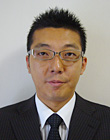
Yu Saito [Profile]
Writing High School Graduation Theses
—Nurturing the power to question and the power to reason—
Yu Saito
Japanese Language Teacher at Chuo University Suginami High School
High School 3rd Year's Graduation Thesis
Since 2004, in the Japanese Department of Chuo University Suginami High School, We have been giving guidance in graduation thesis writing to 3rd year students. Of course, when we say thesis, we aren't expecting the level researchers write in academic essays. To the end, our aim is to have students make logical sentences that are composed coherently, along with an appearance that holds water in public.
Each student has their own topic, such as the legal system, social phenomenon, or literary works, gathers information and draws up a single argument. They do not only report the content of their findings, but are put to task as whether or not they can write content appealing to the reader. Through a series of learning activities of bringing up a question for their topic and making their own assertions, we aim to raise the students' strength in discovering a topic (power to question), and strength in logical thinking (power to reason).
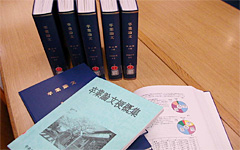
The target length for the essays is 6000 characters. Of course, high school students can write ten to twenty thousand characters if they tried. But if we put too much weight on character length, the content would be spread out in trying to fill in space, resulting in only a general outline of the topic. What is important, is not expanding the topic and writing a lot, but gaining the understanding of a third party and presenting a single, persuasive argument. By investigating the theme in a vertical and deep manner, information unnecessary to the argument can be discarded. It is for that reason the essay is limited to 6000 characters, as it actually contains more than those with no limits.
How does one pose a question?
At the start of the thesis guidance program it was a case of trial and error for the teachers. Coming out of this, the two points that bothered us the most were,
- (1) How does one pose a question? and
- (2) How does one construct an argument?
To a high school student, finding a topic isn't overly difficult. But they don't know how to go about posing a question in relation to the theme they have chosen. Information that can easily be researched (What is the lay judge system?), and information that offers few clues (How can we stop the declining birthrate?), or researching topics that give no immediate answers (Why did Kenji Miyazawa write Night on the Galactic Railroad?), play no function in forming the question that is the prerequisite to the argument. Without being able to decide on an appropriate question, an essay designed to persuade the reader can not be written.
It was there that what we focused on was the importance of a provisional response, or hypothesis, to draw out a question. Because there is a limit to one's knowledge when beginning to deal with a theme, even if one has an awareness of the issues involved, it is only plain and simple. From that, in order to make a question suitable to the argument, one must, first of all, think of a response as a hypothesis, and work back to the question. There is a big gulf between constructing logic and expressing your argument to others. By giving the question a second look based on the hypothesis, and you can begin to see structure of the essay. In the examples given above, it is necessary to at least embody the questions to “What problems have arisen since the introduction of the lay judge system?”, “Can an increase in public spending contribute to a rise in the birth rate?”, and “In what way do the main characters in Night on the Galactic Railroad change?”.
Logic is a pyramid, the argument is a reverse triangle
After finding a hypothesis, the next problem one is confronted with is how to argue for it. This is because you must explain the hypothesis you have found in a way that a third party can understand. There, although it is called logic, when thinking of it in its most basic form, the basics of logic is the combination of assertion (hypothesis) and evidence. Here is how it looks as a diagram.
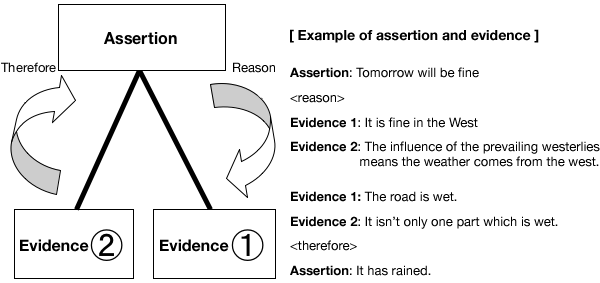
Logic can be formed when you first get your assertion and evidence together. "Assertion is the reason of evidence" or "Evidence therefore assertion" is the basic shape of logic. In addition to that, another element required to express something in words is posing of a problem (question). If the assertion (response) you have prepared can catch the perfunctorily drawn out question, you can produce a reverse triangle as the basic shape of the argument (see diagram below).
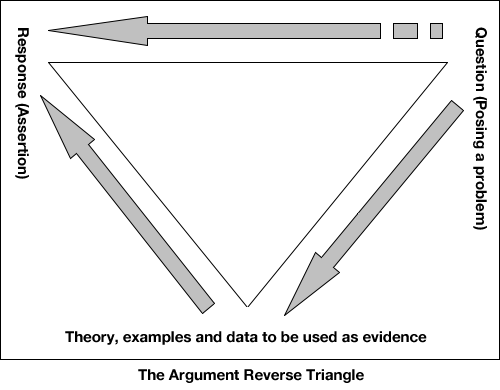
Building an argument with a research map
By using this argument reverse triangle as a format, you can begin to write. This is because it is the answer to point (2) I mentioned earlier in relation to essay writing, “How does one construct an argument?”.Based on the argument reverse triangle, I produced the following A4 size worksheet.
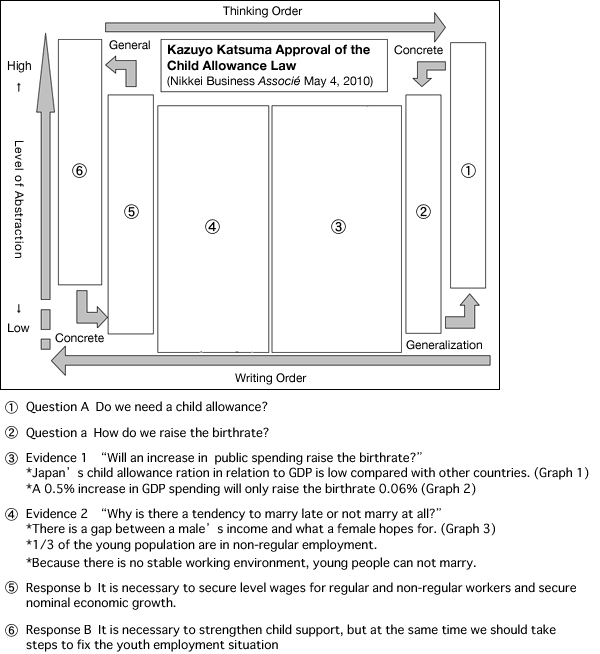
At our school we call this worksheet a research map. We place the argument reverse triangle in a symmetrical space, and to allow the layering of each part, set a vertical axis for level of abstraction. By using this research map we can draw up a strategic argument chart before writing the actual essay.
The example above is a serialized article from a business magazine put into research map format. By putting what was written in here, you can get a grasp of the structure of the content you have read, and at the same time, by putting this into writing, you can compose a condensed version. Moreover, when writing an essay, by following this process in reverse, you can standardize the process as a thought process of creating the argument structure➝writing the essay.
A model for breaking down models
There may be differing views on presenting an arbitrary model like the research map, but as an introduction to essay writing for high school students like those at our school, you need something to point them in the right direction. Most of our third year students enter Chuo University. The research map framework of thinking makes it possible for our students to display independent, free thinking in the institution of higher learning called university, and we think it is preferable to have a function which is a model for breaking down models.
The power to discover a topic (power to question) and the power to display logical thinking (power to reason), are the most important abilities in modern society. Finding an issue, creating a hypothesis and presenting an argument by yourself, in this world with no correct solutions, comes with the difficulties of having to put a process in motion with your own strength. That experience will surely provide valuable hints to survive in a turbulent age.
[References]
Kazuhisa Todayama The Essay Classroom-From Report to Graduation Thesis (2002, NHK Books)
Kazuyoshi Fukuzawa Rules of Debate (2010, NHK Books)
Kazuyo Katsuma The Art of News Work (Nikkei Business Associé May 4, 2010)
- Yu Saito
Japanese Language Teacher at Chuo University Suginami High School - Born in 1975. Graduated from the Faculty of Education at Tokyo Gakugei University. Full time teacher from 2005 after serving as a concurrent teacher at Chuo University Suginami High School. Research member at the Education Institute for Private Schools in Japan 2006-2007. Representative for cooperative school research at the Tokyo Private School Research Institute 2008-2009. Sanseido High School Japanese textbook editing committee member since 2009. Major publications include Essay Guidance for High School Students (Education Institute for Private Schools in Japan Bulletin No. 43). Practice and Theory in Essay Guidance for Nurturing Media Literacy (coauthor, Tokyo Private School Research Institute Bulletin No.57). Shun Medoruma's Tamashikome as 〈Reading Material〉 (Tokyo Gakugei University Japanese Literature No.40)
- Research Activities as a Member of Research Fellowship for Young Scientists (DC1), Japan Society for the Promotion of Science (JSPS) Shuma Tsurumi
- Important Factors for Innovation in Payment Services Nobuhiko Sugiura
- Beyond the Concepts of Fellow Citizens and Foreigners— To Achieve SDGs Goal 10 “Reduce Inequality Within and Among Countries” Rika Lee
- Diary of Struggles in Cambodia Fumie Fukuoka
- How Can We Measure Learning Ability?
—Analysis of a Competency Self-Assessment Questionnaire— Yu Saito / Yoko Neha - The Making of the Movie Kirakira Megane








